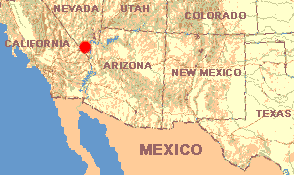 March
28, 1988
March
28, 1988NEVADA: Clark County
Toiyabe National Forest about 20 miles northwest of Las Vegas, on eastern slope of Charleston Peak, elevation ±8000 feet
 March
28, 1988
March
28, 1988The twenty-foot pine above Henry dumbfounds me. Instead of bearing two or more needles per cluster the way any decent pine does, this tree has only a single needle, as if it were a kind of spruce or fir. However, the cones on the ground beneath the tree are unmistakably pinecones.
Finally I remember: I've read about a species of pinyon pine called the Singleleaf Pinyon, Pinus monophylla. Soon a glance in the field guide confirms it: Henry is parked beneath a pine unlike any I've ever seen, and unlike any pine we have in the East!
The next-most prominent tree on this slope is a good- smelling juniper with scale-like leaves and pea-sized, reddish-brown, fleshy, round fruits. In Kentucky we have only one juniper-tree, the Eastern Redcedar, but according to my field guide's distribution maps in this region we have three, or maybe four, or even five. For most of the morning I try to figure out whether this juniper is the One-seed or the Utah juniper, Juniperus monosperma or Juniperus osteosperma, rectively. However, each of our trees' features appear intermediate the two choices. I simply can't figure out which one it is.
In the forest around Henry, the Singleleaf pinyon pine and the juniper are the only two species tall enough to be considered real trees. However, three species of shrub found here are listed in my Golden Guide as sometimes reaching tree size.
The largest, called the Curlleaf Cercocarpus, Cercocarpus ledifolius, is about seven feet tall and much-branched. Its leaves, about an inch long, look like peachtree leaves with curiously curled-under margins. This plant's fruits consist of brown, woody items 2/5 of an inch long and shaped like large grains of rice. Atop these arise curly "wings" looking like slender, thin- haired mouse-tails about 1 inch long. Apparently this appendage enables the seed's dispersal in the wind.
The second bush that sometimes becomes a tree -- only growing to about three feet here -- is the Cliffrose, Cowania mexicana. Its leaves look like half-inch long, evergreen, stiff, white-oak leaves. Each leaf bears so many large, clear or white resinous specks that at first I thought that the bush was infested with aphids. Anatomically the Cliffrose's fruits are very similar to the Curlleaf Cercocarpus's, except that each Curlleaf Cercocarpus blossom produces a single winged fruit, while each Cliffrose blossom produces more than one.
Both species are members of the Rose Family.
The last shrub/tree is the Sagebrush, Artemisia tridentata. Here it's only knee-high and it's hard to imagine it as a tree.
The cold-tolerant cactus that surprised me with its presence next to a snowbank turns out to be a pricklypear called Starvation Cactus, Opuntia polyacantha. Weniger suggests that it may be the most northern of all cacti, with a distribution reaching almost to the Arctic Circle. Since it's found as far south as south-western Texas, it's also one of the most widespread. This pricklypear's skin is wrinkled and its areolae are packed very closely together, and its spines are exceptionally long and slender.
In the area right around Henry, no blooming plants are found. Looking across the valley to higher elevations I see different species of trees -- much taller ones. But that forest seems to have even less to do with the desert than this one, so I'll not go there.